Pulse (1988)
Directed by: Paul Golding
Written by: Paul Golding
Starring: Cliff De Young, Joey Lawrence, Matthew Lawrence, Roxanne Hart
USA
AVAILABLE ON BLU-RAY, 22ND FEBRUARY, from EUREKA ENTERTAINMENT
RUNNING TIME: 91 mins
REVIEWED BY: Dr Lenera
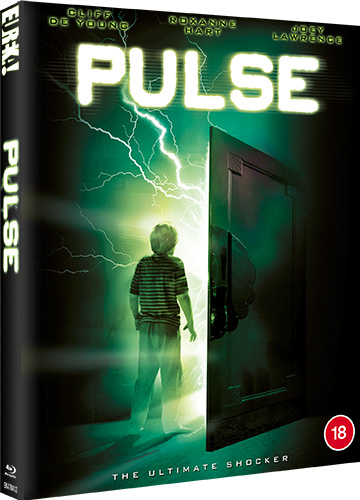
Young David lives with his mother in Colorado but is visiting his father Bill and stepmother Ellen in Los Angeles. One night, while Bill and Ellen attend a social function, David finds that the TV and the washing machine are playing up. Though his fears are dismissed, there’s a house across the street whose previous residents were killed by an electrical fault, and in it David encounters an old man who says that this is one of many houses where he’s seen electricity play strange and deadly tricks. David tries to convince Bill and Ellen that they’re all in great danger….
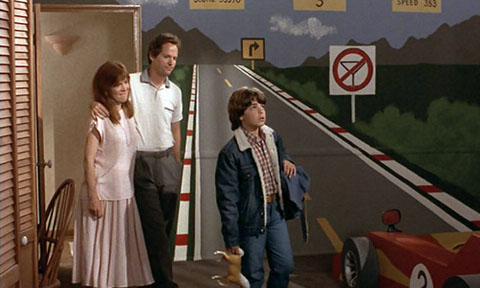
BBFC ratings are often strange things but the one for Pulse is one of the strangest I’ve come across in some time, especially considering that many films once rated ‘18’ are now ‘15’ as it’s assumed that today’s teenagers can take more than their predecessors. With only one scene that could be termed nasty which still doesn’t dwell on the nastiness, and only two bits of bloody injury which aren’t dwelt on either, Pulse could not just be a ‘15’ but, at a push, even a ‘12’. I’d say that it’s a much more appropriate candidate for a ‘12 ‘rating then some other horror films I’ve seen that have the same rating such as Signs and The Woman In Black [even in the UK version’s altered form]. And it actually has a ‘PG-13’ rating in North America. I recall watching it on ITV at 8 o’ clock in the evening, in fact we all watched it as a family, my two much younger brothers being pleasantly scared a little but not to the point where my mother and stepfather got worried – though of course being a highly responsible older brother I’d already shown them a few things I shouldn’t have. But don’t let all this put you off checking out this effective if very simple and stripped down little gem [which has nothing to do with the also very good Japanese film of the same name or its American remake] which plays rather well with the idea of how dangerous electrical objects really are and how frightening they therefore can be even though we don’t tend to think of electricity as bad and it’s something that we rely on. With its very small cast of characters, you shouldn’t expect much of a body count; the Final Destination movies, the first three of which are pretty good, are the ones you should go for if you want some elaborate deaths involving electricity. But Pulse is undeniably well handled by its writer/director Paul Harding, while its central theme of our reliance of technology is even more pertinent today then it was in 1988.
Harding was a maker of short films, sometimes with George Lucas. The idea for Pulse came to him from two sources. The first was when the screenwriter Caleb Deschanel spent the night in his house and over breakfast told him that at night he’d been listening to “the sounds of the house…..the house was alive and it was taking care of me“. The second was when he heard about a computer that reprogrammed itself .He wrote the screenplay for what was also called House, Tract and Currents in 1981 but couldn’t get it made until Columbia eventually took it on seven years later. David Morse and Tommy Lee Jones both auditioned for the role of Bill but lost to Cliff De Young. When Joey Lawrence came in to read for the lead part, his parents suggested to Golding that he should consider casting Lawrence’s younger brother Matthew in the smaller part of neighbor Stevie. Matthew was cast after he nailed Stevie’s curbside speech at his audition which he’d memorised. Principal shooting was completed one day early and a million dollars under its six million dollar budget, meaning that they were able to afford a fairly ‘hot’ at the time group called Oxford Scientific Films to do many of the special effects which they created in Oxford. The original cut was two hours long and included scenes of scenes of David with his mum and Ellen talking of seeing powerlines being built as a child among other things. David Picker the head of Paramount loved it and intended to give it a big release, but then the studio changed hands and only released it in Texas and Oklahoma, while it went straight to video elsewhere. However, it became a success on that format despite rather misleading cover art on some releases, which beggars the question; why didn’t Harding make any more films?
The early scenes, right down to the first few seconds, set us up for what is to come so we don’t mind that over half of the film is build-up. The first thing we see in what is presumably an electric pulse moving across a black screen, then a factory in the distance while an explosion occurs in the foreground. We are shown circuit boards and other forms of electrical equipment, then pylons and power poles, before we alight on a couple in bed at night. The husband hears noises emitting from one of the houses opposite where something rather horrid is happening. The police break into a flooded, smashed up house and come across a rather odd dead body. We have actually been shown very little, but certainly have some idea of what’s happened. Now we meet little David on a plane to go and stay with his father Bill, and technology is soon shown to be either flawed or not having much point to it; the window of David’s car must not be wound down because it won’t come back up, while David’s mother apparently has a microwave she never uses because she’s heard it makes people sterile. David is the product of a broken home which is undeniably an easy way for us to have sympathy for him, though he’s shown to be moody and even rude too, like when he refuses to eat the pasta that Bill’s wife Ellen has cooked for him because it has too many mushrooms, and neither apologises nor says thank you when she goes off to get him some soup instead. One nice switch around from the norm is that David actually likes his stepmother and spends much more time with her, while he doesn’t get to see his dad much at all because he’s always at work. He fails to impress the local kids with his skateboarding, but does befriend the younger Stevie, and his subplot doesn’t entirely come off because it’s obvious that both boys are being played by ones who are closely related too each other, they look so similar.
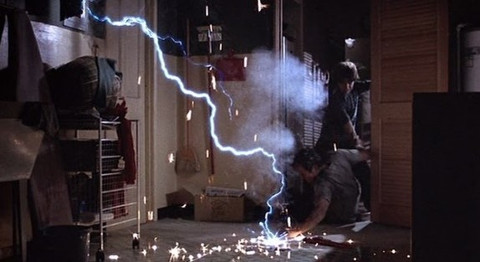
Ellen suggests they all watch a basketball game on TV and then a video, but then Bill suddenly remembers that he and Ellen are obliged to go to a party so David’s home alone for the evening. The TV suddenly switches off on its own, then comes back on but with no sound and a laser moving about on a black screen. Even though we know this is not the work of ghosts, it’s quite eerie, as if something is trying to reach out and come into our world. David is able to hear the game on the radio and then the TV comes back on properly, but now won’t be turned off, while the washing machine’s dryer also comes on for some reason, scaring David considerably. Bill and Ellie come home to find him in a right state, but of course don’t believe him. There’s a great little scene which takes place the next day where a smug repairman [a funny turn by Robert Romanus] puts the problem down to pulses [overloads from the transforming station coming back through the wires] but admits that he has no idea of why this is happened, then picks up the manual and smarmily says, “I read the book, I do what it says”, admitting that he just blindly follows the manual and therefore isn’t much good with all these increasingly difficult circuits one gets these days. Then there’s the creepy old man who looks after the house situated opposite where the events at the beginning took place. When David breaks into the boarded-up place, he’s initially scared by the old man who then talks about “the voice in the wires”, advises David to “pull out all the plugs”, admits that he lives on “wood fires and kerosene lamps”, and says that “paranoia is just another name for heightened awareness”. But dad still doesn’t believe him and part drags, part carries him back into the house in front of loads of neighbours who probably think ill of what David is doing.
Now if this film had been made today, we’d probably have had some more peripheral characters who might venture into the house and be killed off in some inventive way involving some of the many sources of electricity there. This means that it’s possible that some first time viewers today might be disappointed by the lengthy build-up and the fact that not as much happens as they possibly expected, but then Golding seems more interested in creating uneasy suspense than the release thereafter, even if he does deliver a memorable shower set piece and a thrilling climax with some effective use of slow motion. And he certainly proves himself capable of achieving his aim, to the point where you are on tenterhooks as one of the characters passes by something electrical, even something seemingly innocuous. The camera doesn’t just creep through the house and makes sure that we notice all the objects that could cause harm, it even delves inside electrics and treats us to some rather startling shots of pieces of solder dividing, splitting, and giving birth to new ones, and things melting, realised by an early version of the morphing technology used in Terminator 2: Judgement Day. It almost looks like we’re watching actual organisms, though any explanation of what’s really going is missing. It seems highly likely that we’re going to get a scene where the old man explains things, and he does seem to know more than he’s letting on, but said expected scene refuses to materialise. This is probably something that pleases half of the people who watch Pulse and annoys the other half.
The sound effects are terrific and pitched at just the right level, emphasising all the hummings, clickings and buzzings you’d expect to hear without going over the top. Jay Ferguson’s electronic score also adds to the ambience as well as being a good example of its type. The poor plight of a kid who’s having a hard time accepting the fact that his parents will never get back together and then can’t convince his father and stepmother that their house is very dangerous is definitely felt, David being very played by Joey Lawrence who kept busy as both a child and an adult actor though never really made it. Cliff De Young and Roxanne Hart are both excellent as Bill and Ellen – they feel like real people even if the writing isn’t deep [and shouldn’t need to be] and Golding’s blocking of them isn’t always too great. His script has some minor lapses in logic and one major one; there’s sometimes danger from non-electric things for some reason. One can also say that possibly it could have gone a bit further with the concept, but then there’s much to be said for holding back when so many movies go over the top, especially today. Overall, Pulse does look and feel a bit like a TV movie, but that doesn’t have to be a bad thing – in the ’80s and especially the ’70s there were a lot of really good TV movies, many of them horror. It’s a good example of how horror can take something familiar, something that’s part of everyday life, something that people take for granted, and make it unnatural, scary and dangerous, and the final aerial shots of Los Angeles looking like one giant circuit board help ensure that an uneasy feeling stays with you. After watching it, you may worry just a little when you switch your TV on, panic just a little when your washing machine throbs, or – as I did – flinch just a little when your heating comes on. And let’s not forget our reliance on digital these days. There’s so much that could go wrong….
Rating: 









SPECIAL FEATURES
Limited Edition O-Card slipcase [2000 copies]
1080p presentation on Blu-ray
The first Blu-ray release of Pulse was by Mill Creek in North America on a disc with not even a trailer as additional value. Eureka probably have used their restoration and given it a new encode. The first few minutes show signs of wear and tear, but the rest of the film only had the odd little speck popping up. Colours look natural, grain seems evenly managed, image is quite sharp yet the movie still seems of its time. Not a spectacular effort but still a pretty good one, and I can’t imagine the film ever having looked that great in the first place.
LPCM 2.0 audio
Optional English SDH
Brand new audio commentary by author and film historian Amanda Reyes
I don’t think Reyes is somebody I’ve come across before, but she provides a strong audio commentary, even if she sometimes seems to struggle to cram in everything that’s all on her notes, and sometimes seems to mark time by slightly digressing. She’s not very scene specific either, and there obviously wasn’t much more background then I could find. However, she’s really strong on theme and symbolism without ever getting too dry, such as when she says how Pulse is one of many of the time which deal with anxieties of suburbia, and might increase your appreciation of the film. Some interesting-sounding similar films too which the Doc might check out. Best of all, she’s clearly loving talking about a movie she’s obviously a fan of.
Tuning in to Tech Horror – video essay by writer and film historian Lee Gambin [14 mins]
Well if this short featurette has done one thing it’s made me want to see a film called Murder By Phone which sounds very good indeed. Gambin describes many films that deal with tech horror – some well known, some not – while mentioning that it was reaction to what was an age of excess and a largely male-fixated subgenre.
Limited Edition collector’s booklet featuring a new essay by film scholar and author Craig Ian Mann; and an article on the film by filmmaker
Adrián García Bogliano (Dark Phases) [2000 copies
‘Pulse’ might be limited, it doesn’t set its sights very high, but it really works. Recommended.


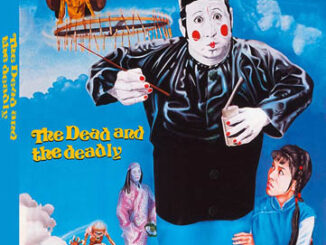
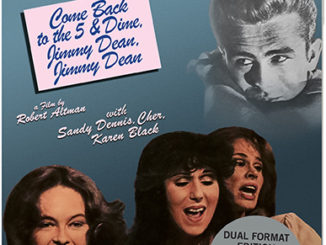

Be the first to comment